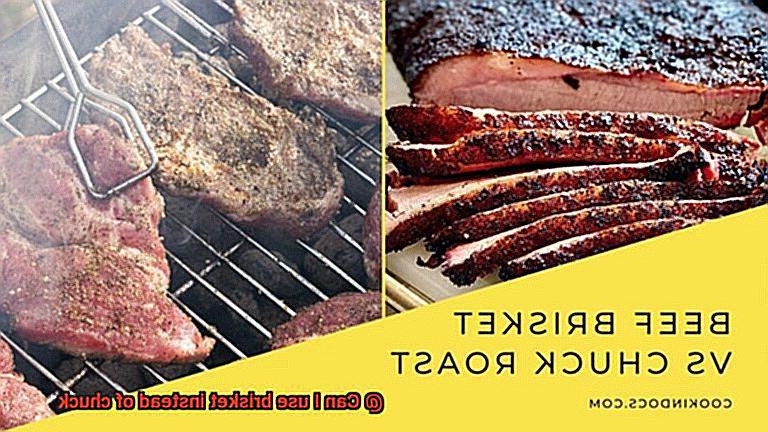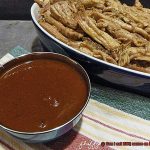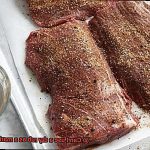Do you crave mouth-watering, slow-cooked beef dishes that practically melt in your mouth? If so, you may have considered swapping out chuck for brisket to switch things up in the kitchen. But can you really make the substitution?
That’s a question many home cooks ask themselves when planning their next meal. Although both cuts come from the shoulder area of the cow, they have distinct qualities that lend themselves better to certain dishes.
In this blog post, we’ll explore the differences between brisket and chuck and weigh the pros and cons of using one over the other. We’ll also share some popular recipes where you can make the switch with ease, as well as a few where it’s best to stick with chuck.
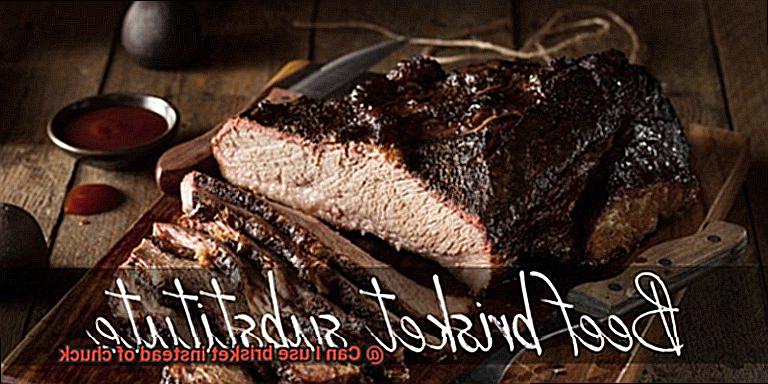
But before we dive into all that juicy goodness, let’s start with a fun fact: did you know that Texans consider brisket to be one of their favorite cuts of beef? It’s true. The Lone Star State is famous for its brisket BBQ because of its unique flavor profile, texture, and tenderness.
Now that we’ve got your taste buds tingling, let’s get down to business and explore whether or not using brisket instead of chuck is a good idea.
Contents
What is Brisket?
Brisket is a tantalizingly flavorful cut of beef that hails from the lower chest or breast of the cow. Its unique taste and texture have made it a popular choice for smoking and slow-cooking. You can buy brisket either as a whole cut, which can weigh anywhere from 8 to 20 pounds, or as smaller portions like the point or flat cut.
The point cut is thicker and has more marbling, making it ideal for smoking, while the flat cut is leaner and easier to slice, which makes it perfect for sandwiches. Regardless of which cut you choose, both require different cooking techniques due to their size and fat content.
One of the most popular ways to cook brisket is by smoking it for up to 18 hours over low heat using oak or mesquite wood. This method produces tender, juicy meat that’s packed with smoky flavor. However, brisket can also be braised in liquid or roasted in the oven depending on personal preference.
When buying brisket, look for a piece with a good amount of fat on top. This layer of fat will help keep the meat moist during cooking and enhance its flavor. However, if you prefer less fat in your meal, trimming some of the excess fat off beforehand is an option.
Brisket is a staple in Texas-style barbecue, where it’s often served with classic sides like coleslaw and baked beans. But the versatility of this meat means it can also be used in a variety of dishes, from stews to tacos to sandwiches.
What is Chuck?
Allow me to enlighten you on this succulent cut of beef.
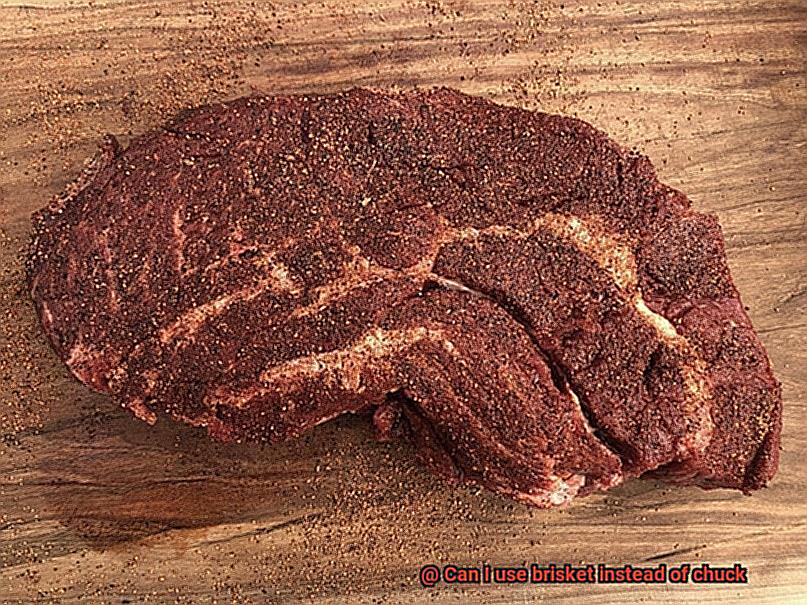
Chuck is derived from the cow’s shoulder and boasts a delectable flavor and tender texture. It’s perfect for various dishes such as stews, roasts, and ground beef. Plus, its marbling ensures it remains juicy and moist during cooking.
It’s worth noting that there are multiple cuts of chuck available, each with distinct qualities. You’ll find chuck roast, chuck steak, and chuck eye steak, all of which can be prepared in different ways depending on your recipe.
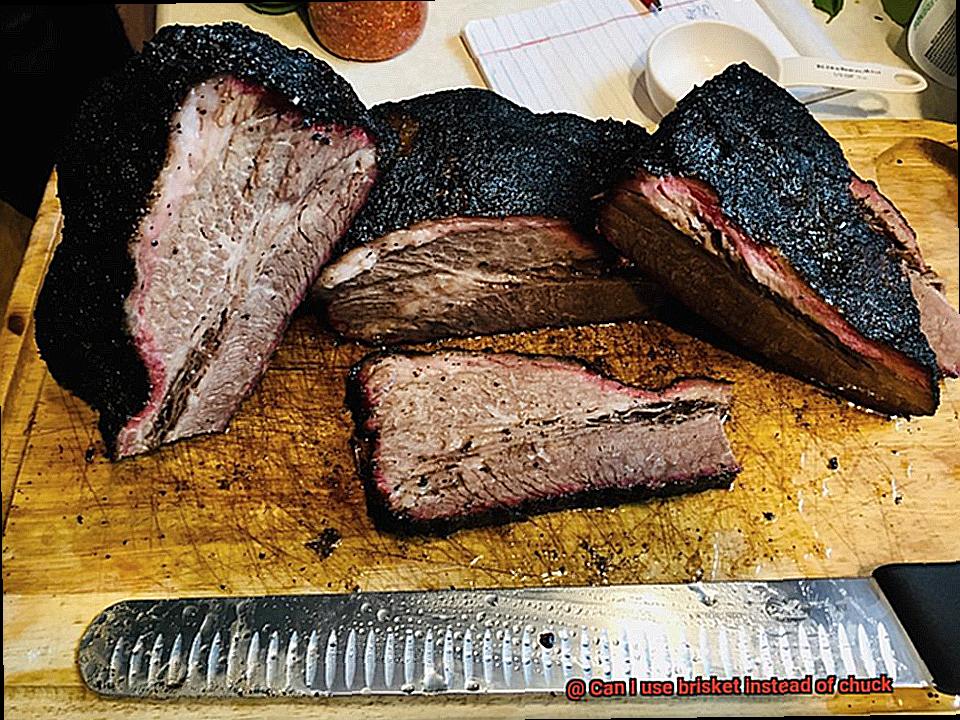
One of the reasons why chuck is so popular is its suitability for grilling. With its high-fat content, it doesn’t dry out easily and pairs well with various marinades and seasonings.
However, don’t mistake chuck for brisket. While both are beef cuts, they originate from different parts of the cow and have different textures. Brisket requires slow cooking at low temperatures to tenderize its tough texture.
While some recipes may allow you to substitute brisket for chuck, expect longer cooking times or different cooking methods to achieve the same outcome. Make sure to assess your recipe beforehand to determine which cut is best.
Differences Between Brisket and Chuck
Then, you must know the differences between brisket and chuck. These two cuts of beef may appear similar, but they have distinct differences that can make or break your recipe.
Firstly, let’s dive into brisket. This cut comes from the lower chest of the cow and is known for its large size and tough texture. It has two muscles – the flat and the point – which require different cooking methods. The flat is leaner and requires slow cooking to break down the tough fibers and become tender, while the point is fattier and more tender, making it perfect for smoking or braising. Brisket is famous in Texas-style barbecue, where it’s smoked low and slow to develop its rich flavors and tender texture.
On the other hand, chuck comes from the shoulder of the cow and is also a tough cut of meat. However, it has a good amount of marbling that makes it juicy and flavorful. Chuck roast is often used for pot roasts, stews, and braised dishes. Chuck can be grilled with high heat to develop a nice char on the outside while remaining juicy on the inside.
If you’re thinking about substituting one cut for another, keep in mind that brisket can be used instead of chuck in some recipes but may require adjustments in cooking time and method. Chuck may not be a suitable substitute for brisket in recipes that require slow cooking or smoking.
To summarize, understanding the differences between these cuts is essential for anyone who wants to achieve the best results in their grilling recipes. Here’s a quick rundown of their differences:
- Brisket: tough, leaner flat muscle, fattier point muscle, requires slow cooking or smoking
- Chuck: also tough, flavorful due to marbling, can be grilled with high heat
Can You Use Brisket Instead of Chuck for Grilling?
Perhaps you’ve wondered whether using brisket instead of chuck could take your grilling game to the next level. While these two cuts of beef share similarities, there are key differences that can impact your grilling experience.
Brisket is widely known for its rich, intense flavor, but it also has a higher fat content and tougher texture than chuck. This means that it requires low heat and a long cooking time to break down the collagen and connective tissue properly. In contrast, chuck boasts a mild flavor and tender texture, making it ideal for grilling at higher temperatures.
If you’re curious about using brisket instead of chuck for grilling, the answer is yes, with some caveats. To make the most of this cut, use the flat or “first cut,” which has less fat than the point cut. It’s also essential to marinate the meat beforehand to help tenderize it.
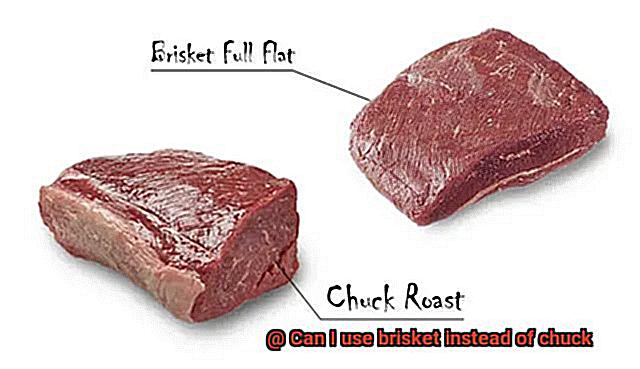
When it comes to cooking, you’ll need to grill brisket at a lower temperature for an extended period. This means cooking for up to 10 hours at 250-275°F to achieve a juicy and tender result. While this may seem like a considerable time investment, the reward of delicious brisket will leave you satisfied.
If you’re pressed for time or don’t want to go through the extra steps involved in grilling brisket, chuck remains an excellent option. It’s easy to grill and has a more moderate flavor that pairs well with various seasonings and sauces.
How to Grill Brisket Versus Chuck?
Grilling meat requires careful consideration of the cut to achieve the perfect flavor and texture. Two common cuts that are often compared are brisket and chuck. Although both are tough cuts of meat that require slow cooking to become tender, they have unique differences in texture and flavor. Here are some key differences in grilling techniques for brisket versus chuck:
- >Cut of Meat: Brisket and chuck come from different parts of the cow. Brisket comes from the chest area while chuck comes from the shoulder area, meaning they have different textures and flavors.
- Texture: Brisket is a tough, fibrous cut of meat with a distinct grain that requires low and slow cooking over indirect heat to become tender. Chuck, on the other hand, has more marbling than brisket, making it more forgiving when grilled.
- Flavor: Brisket has a more pronounced beefy flavor compared to chuck, which has a less pronounced flavor but is more versatile and can be used in a variety of dishes.
- Cooking Method: When grilling brisket, low and slow cooking over indirect heat is recommended, while chuck can be cooked over direct or indirect heat depending on the recipe.
- Internal Temperature: Brisket needs to reach an internal temperature of 195-205 degrees Fahrenheit to become tender, while chuck should be cooked to an internal temperature of 160-170 degrees Fahrenheit.
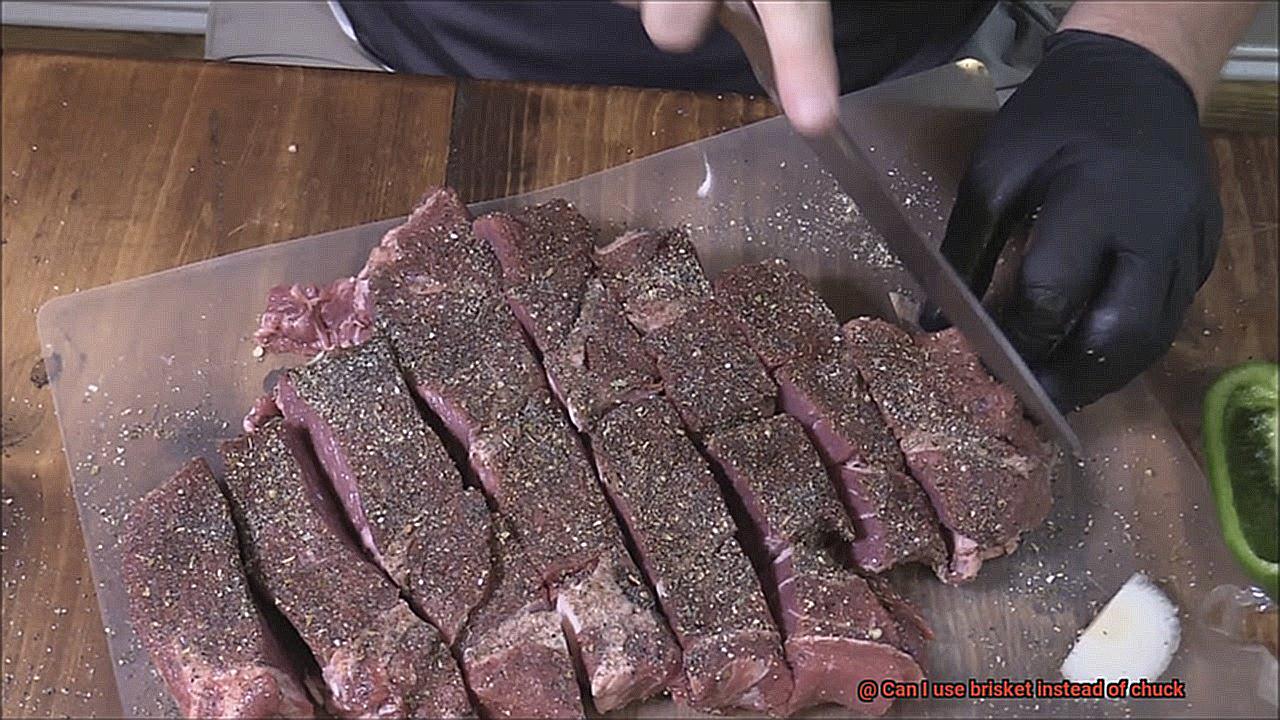
When grilling brisket, it’s crucial to season it well with a dry rub or marinade before cooking it slowly over indirect heat for several hours. This technique breaks down the collagen and tenderizes the meat, resulting in a juicy and flavorful brisket. It’s also important to wrap the brisket in foil or butcher paper during cooking to help retain moisture.
For chuck, grilling over high heat for a shorter period is recommended. Still, it’s essential to keep an eye on the internal temperature to avoid overcooking and drying out the meat. Chuck is often used for burgers, stews, and roasts, making it a more versatile cut of meat that can be cooked using any method.
Finally, both cuts of meat need to rest for a few minutes before slicing to allow the juices to redistribute. While brisket and chuck have their unique challenges when grilling, they can be used interchangeably in certain recipes. For example, ground chuck or ground brisket can be used in burgers or meatballs without much difference in flavor or texture. However, for slow-cooked barbecue dishes like pulled pork or beef brisket, sticking with the specific cut of recommended meat in the recipe yields optimal results.
Flavor Comparison Between Brisket and Chuck
Let’s explore the flavors of these two beef cuts to help you make an informed decision.
First up is brisket – the undisputed king of barbecue. This cut comes from the chest of the cow and is known for its rich, beefy flavor and tender texture. The high amount of marbling in brisket provides it with its signature flavor and tenderness that melts in your mouth, leaving you craving more. If you’re a fan of traditional barbecue recipes, brisket is the perfect choice.
Now, let’s move on to chuck. This cut comes from the shoulder of the cow and boasts a beefy, robust flavor that is not as rich as brisket. Chuck is also known for its affordability and versatility in cooking. It’s an excellent option for stews or roasts and can be just as delicious as brisket when cooked correctly.
When comparing the two cuts, it’s essential to consider your personal preferences and the dish you’re preparing. If you’re looking for a tender and flavorful cut for barbecue, then go for brisket. However, if you want an affordable and versatile cut for stews or roasts, chuck may be more suitable.
Cost Comparison Between Brisket and Chuck
Let me enlighten you on the cost comparison between brisket and chuck and help you decide which one to opt for.
Firstly, it’s important to note that brisket is generally more expensive than chuck. However, the price can vary depending on where you live and where you purchase your meat. Hence, it would be wise to do some market research or look out for sales to get the best deal.
One of the primary reasons for the higher cost of brisket is its size. It’s a larger cut of meat than chuck and includes both the flat and point. As a result, brisket takes longer to cook, which can also contribute to its higher price point.
On the other hand, chuck comes from the shoulder area of the cow and is typically a more affordable option. It’s also an adaptable cut of meat that can be used in various dishes, including stews, roasts, and ground beef. So not only will it save you some money, but it’s also versatile.
If you’re planning to cook for a large number of people or want to prepare meals for multiple days, investing in brisket may be worth it due to its larger size and ability to provide more servings. Additionally, because brisket requires longer cooking times, it can be an excellent option for meal prepping or feeding a large group. And let’s not forget the marbled fat that gives brisket its unique flavor.
However, if your dish doesn’t require a large cut of meat or doesn’t need to be as tender as brisket, chuck is a great option that won’t burn a hole in your pocket. You can use chuck in various dishes and still have an appetizing meal without breaking your bank.
5coWx2PbwZ8″ >
Conclusion
In conclusion, the decision to use brisket instead of chuck depends on a variety of factors. Your personal preferences, recipe requirements, and cooking techniques all come into play when selecting the perfect cut of beef for your dish.
Brisket is a larger cut with a higher fat content that requires low and slow cooking to achieve tenderness. Its unique texture and flavor make it ideal for smoking or slow-cooking, making it a staple in Texas-style barbecue. On the other hand, chuck has more marbling than brisket, which makes it more forgiving when grilled. It’s perfect for stews or roasts and can be just as delicious as brisket if cooked correctly.
When comparing these two cuts, you must consider your budget along with your personal preferences. While brisket may cost more due to its size and longer cooking time, it could be worth investing in if you’re cooking for a large group or meal prepping. Chuck is an affordable option that’s versatile enough to use in various dishes without breaking the bank.
Ultimately, understanding the differences between these cuts is crucial for achieving optimal results in your grilling recipes. Whether you choose brisket or chuck, both have unique flavors and textures that will leave your taste buds satisfied.

